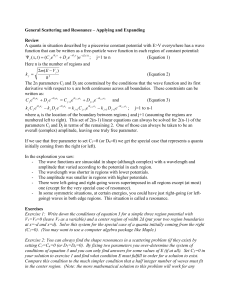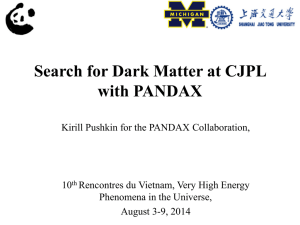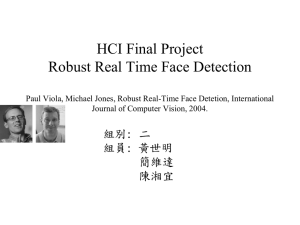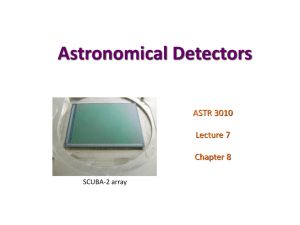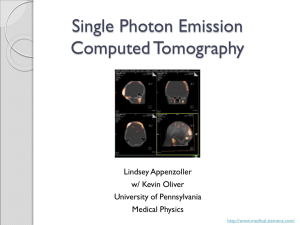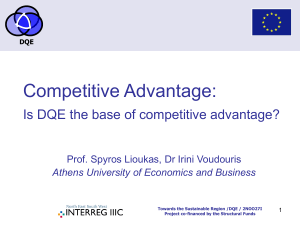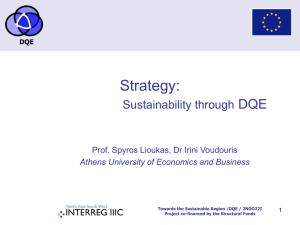The role of the false events on the DQE measurement of the
advertisement
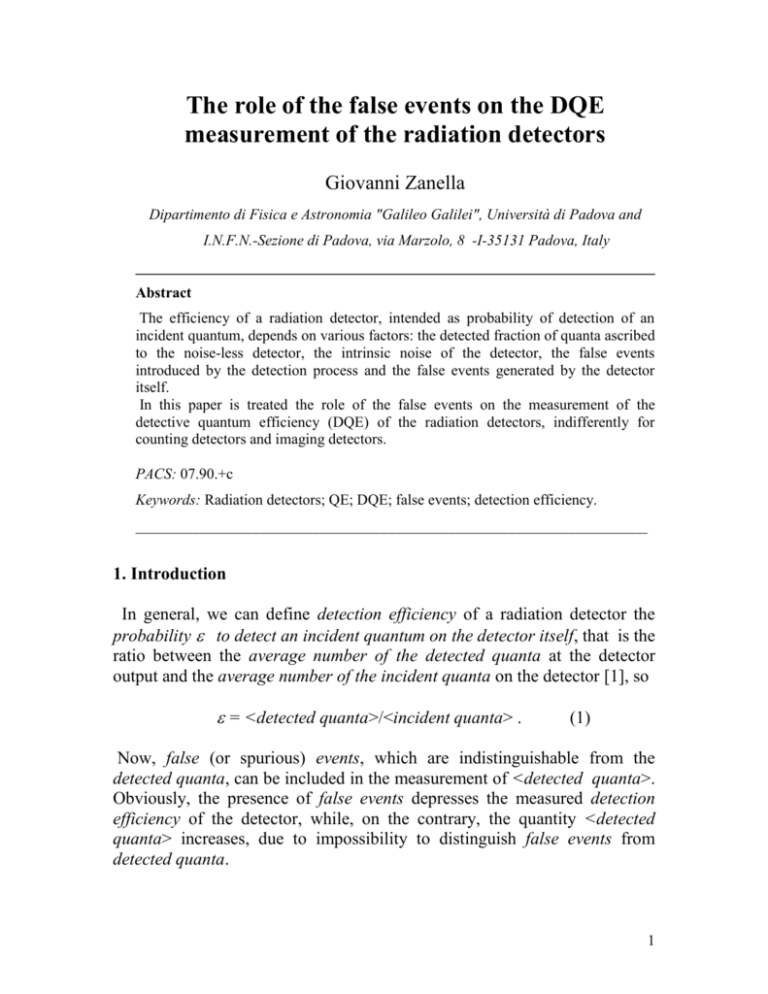
The role of the false events on the DQE measurement of the radiation detectors Giovanni Zanella Dipartimento di Fisica e Astronomia "Galileo Galilei", Università di Padova and I.N.F.N.-Sezione di Padova, via Marzolo, 8 -I-35131 Padova, Italy _____________________________________________________________________ Abstract The efficiency of a radiation detector, intended as probability of detection of an incident quantum, depends on various factors: the detected fraction of quanta ascribed to the noise-less detector, the intrinsic noise of the detector, the false events introduced by the detection process and the false events generated by the detector itself. In this paper is treated the role of the false events on the measurement of the detective quantum efficiency (DQE) of the radiation detectors, indifferently for counting detectors and imaging detectors. PACS: 07.90.+c Keywords: Radiation detectors; QE; DQE; false events; detection efficiency. ____________________________________________________________________ 1. Introduction In general, we can define detection efficiency of a radiation detector the probability to detect an incident quantum on the detector itself, that is the ratio between the average number of the detected quanta at the detector output and the average number of the incident quanta on the detector [1], so = <detected quanta>/<incident quanta> . (1) Now, false (or spurious) events, which are indistinguishable from the detected quanta, can be included in the measurement of <detected quanta>. Obviously, the presence of false events depresses the measured detection efficiency of the detector, while, on the contrary, the quantity <detected quanta> increases, due to impossibility to distinguish false events from detected quanta. 1 Hence, the expression (1) has a theoretical validity, but it is not useful for the measurement of . We can define two types of detection efficiency: the quantum efficiency (QE), which supposes the absence of false events in the noise-less detector and the detective quantum efficiency (DQE) which including the false events in the noisy detector, becomes the real detection efficiency. As concerns the measurement of DQE, we have considered in a previous paper [2] only the incidence of the false events introduced by the detector. Instead, in the present paper, we consider two types of false events : 1. False events generated by the detector and as such their number is averagely steady during a same time interval and on a same detector area. 2. False events generated in the interaction of the incident quanta with the detector (i.e. Compton events in a gamma detector) and as such their number increases with the incident quanta. Now, if the incidence on DQE of the false events of type 1 can be nullified, for the Poisson fluctuations associated to an elevated number of incident quanta, the false events of type 2 result more dangerous, because they depress DQE without remedy. Due to impossibility to distinguish detected quanta from false events, the false events of type 2 influence the measurement of QE, forcing us to its computation, necessary for the determination of DQE. The following treatment is common to the counting detectors (including the visualizing ones), in which the events are recognized singularly, and to the integrating detectors, in which the events are summed in the pixels of the detector to form images. Besides, the output signal is intended on all the bandwidth of the detector. 2. The quantum efficiency (QE) Applying Eq. (1) to a noise-less detector and in absence of false events, we can write QE So Si , (2) where S o denotes the average number of detected quanta at the detector output and S i the average number of incident quanta on the detector. 2 Obviously, the previous means are intended on a same time interval and on a same area of detector. It is possible to find an equivalent representation of QE, in place of Eq.(2), if Poisson statistics is attributed to the incident quanta. Indeed, S i represents the variance i2 of the incident quanta, while the variance of the detected quanta is o2 QE Si [3]. Thus 2 So QE So Si So 2 Si So 2 o2 Si 2 SNRo SNRi 2 2 , (3) i2 Si where SNRo denotes the average signal-to-noise ratio at the detector output and SNRi the average signal-to-noise ratio at the detector input. As, the measurement of QE is not possible in presence of false events, for the indistinguishability with the detected quanta, it is necessary its indirect determination, either as limit case of DQE, when we increase S i , or by its computation, if nature and energy of the incident particles, as well as the interaction process with the detector, are known. 3. DQE and false events In analogy with Eq.(3), defined as: DQE SNRo SNRi DQE of a radiation detector is commonly 2 2 2 So o2 Si 2 QE 2 S i S i o2 2 QE 2 S i o2 , (4) Si where o2 is not simply the Poisson variance QE Si of Eq.(3), because the presence of false events and the intrinsic noise of the detector is now 2 2 considered. Instead, S o of Eq.(4) is necessarily QE 2 S i as in Eq.(3), because the false events must be excluded from the output signal, which pertains only the detected quanta, while other Gaussian noises do not alter its average value. As concerns o2 of Eq.(4), it is the sum of various independent variances, that is (ascribing Poisson statistics also to the false events) 3 02 QE Si f QE Si f d d2 , (5) where: f is the average number of false events per detected quantum, f d is the average number of false events generated by the detector and d2 represents the variance of the Gaussian noise introduced by the detector. In Eq.(5) f and f d are obviously measured on the same time interval and detector area of S i and S o . Therefore, we can write DQE QE f d2 1 f d QE S i , (6) It is evident in Eq.(6) that if f f d d2 0 (absence of false events in a noise-less detector) thus DQE = QE, so DQE QE in any case. The contribution of f appears in the following simple example: if the number of the false events is averagely equal to the number of the detected quanta, that is f 1 , the detection efficiency is halved, also if f d d2 0 . It is also evident in Eq. (6) that, increasing S i , the noise variance QE S i f QE S i dominates on f d d2 , so DQE can tend to QE / 1 f , or to QE , if f 0 . Therefore, differently on QE, DQE depends on S i , as well as on the nature of the incident quanta and on the detector. 4. DQE measurement We can rewrite Eq.(6) as DQE QE 2 S i QE S i f QE S i f d d2 QE 2 S i n2 (7) where n2 is the total variance of the signal at the detector output. So, the measurement of DQE involves measurable quantities as S i and n2 , but also a not-measurable quantity in presence of false events, that is QE. On the contrary, looking at Eq.(6), if the false events are due only to detector, or 4 they do not appear, it would be possible to measure QE as limit of DQE by increasing S i . Therefore, when there are false events associated to the detected quanta ( f 0 ), QE must be computed by knowing nature and energy of incident quanta, as well as the physical properties of the detector and the interaction particle-detector. Hence, we can determine DQE, being known QE, by measuring (in quanta) both S i , with an independent detector, and n2 by the fluctuations of S o . Attention must be paid to the measurement of n , because if S i is measured in quanta, also n2 must be measured in quanta. Thus, if the detector is not counting, it is necessary to know the detector response (pixel by pixel) to a single incident quantum and to distribute averagely this response on the same detector area, involved in the measurement of the fluctuations of S o in quanta. 5. Conclusions This paper treats the role of the false events in the measurement of QE and DQE of any radiation detector. Two types of false events are involved in the detection process: 1. False events which depend only from the detector. 2. False events associated to the detected quanta. While the incidence on DQE of the false events of type 1 can be vanished by increasing the mean of the incident quanta, false events of type 2 engrave on DQE as QE /(1 f ) , being f the mean of false events per detected quantum. Besides, false events of type 2 prevent the measurement of QE, which knowledge is essential for the determination of DQE, forcing us to its analytical calculation. In this paper, the treatment has been common both to the counting detectors (including the visualizing ones) and the integrating (also imaging) detectors, while the output signal is intended on all the bandwidth of the detector. 6. References [1] G. F. Knoll, Radiation Detection and Measurement J. Wiley & Sons, Inc. N.Y. (2000). [2] G. Zanella, Nucl. Instr. and Meth. A 586 (2008) 372-373 [3] G. Zanella and R. Zannoni, Nucl. Instr. and Meth. A 381 (1996) 157-160. 5

